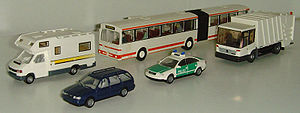
Wiking
Encyclopedia

Waffen-SS
The Waffen-SS was a multi-ethnic and multi-national military force of the Third Reich. It constituted the armed wing of the Schutzstaffel or SS, an organ of the Nazi Party. The Waffen-SS saw action throughout World War II and grew from three regiments to over 38 divisions, and served alongside...
division, see 5th SS Panzer Division Wiking
5th SS Panzer Division Wiking
The 5th SS Panzer Division Wiking was one of the elite Panzer divisions of the thirty eight Waffen SS divisions. It was recruited from foreign volunteers, from Scandinavia, Finland, Estonia, The Netherlands, and Belgium under the command of German officers...
Wiking is a German manufacturer of scale model
Scale model
A scale model is a physical model, a representation or copy of an object that is larger or smaller than the actual size of the object, which seeks to maintain the relative proportions of the physical size of the original object. Very often the scale model is used as a guide to making the object in...
s in H0 scale and N scale
N scale
N scale is a popular model railway scale/track gauge. Depending upon the manufacturer , the scale ranges from 1:148 to 1:160. In all cases, the gauge is . The term N gauge refers to the track dimensions, but in the UK in particular N gauge refers to a 1:148 scale with track gauge modelling...
for model trains. They specialize in models of cars and trucks dating from the 50s to the present day.
Wiking began producing ship models in the 1930s. These metal ships were made in 1:1250 scale. Before and during World War II they were used by the German military for training purposes. The military also used new plane models beginning in 1934/35, and the so called Wehrmachtsmodelle (from 1937/38), models of military vehicles and artillery, both in 1:200 scale. Beginning in 1938 the planes and some of the ships were made from plastic. Based on the Wehrmachtsmodelle, Wiking also made some civilian traffic models whose production was stopped at the beginning of World War II. During the war Wiking mostly produced models for the military as it was considered to be important for the war effort. During the war Wiking employed forced labour, e.g. from Russia.
After World War II there were some experiments with a variety of model topics such as Noah's ark, some clay models, plastic combs and buttons before Wiking started to build model cars. Additionally, there was a small series with models of the Berlin Airlift (1948/49) consisting of five planes and two car models in the scale of 1:400.
In 1947 Wiking started to produce simple car models that mostly consisted of one part, having no windows and no chassis.
They were made of plastic and roughly in the scale of 1:100.
The axles were made of wire with flat pinched ends, that were squeezed into the still warm vehicle body plastic and not able to rotate. Only the wheels rolled on the axles. Later models included a chassis and rolling axles. The scale was changed to 1:90.
Since the early 1960s the models received transparent windows, and in the 1970s interiors were added.
For some models today even the original paint from the car manufacturers is used. The scale has been changed to 1:87 (H0).
Since 1969 Wiking has produced car models in 1:160(N) scale which are mostly for N-Scale model train sets.
Between 1949/50 and 1974/75 Wiking again produced ship models. They also tried to sell plane models again in the 1960s but this effort was cancelled as well.
The founder of Wiking died in 1981 at the age of 78 (February 5, 1903 - November 20, 1981). Some collectors consider this to be the end of an era, leaving behind the age of stylized models.
In 1953 the workshops in Buer were closed, followed by the Kiel workshops in 1982.
In 1984 Wiking was sold to the Sieper Group (Siku). The current models of Wiking represent a different philosophy and try to be a perfect miniature just like the competition (Herpa or Brekina).
By now old Wiking models are often rare collectors items which can be very expensive. The most expensive Wiking model ever sold is a Mercedes tank truck from 1962 which was produced as an advertising article for the Thyssen company. In June 2006 one of these tank truck models was sold for 10,100 Euro at an auction in Cologne.

